Sensory Play: Mom Shares Ideas for Babies and Children
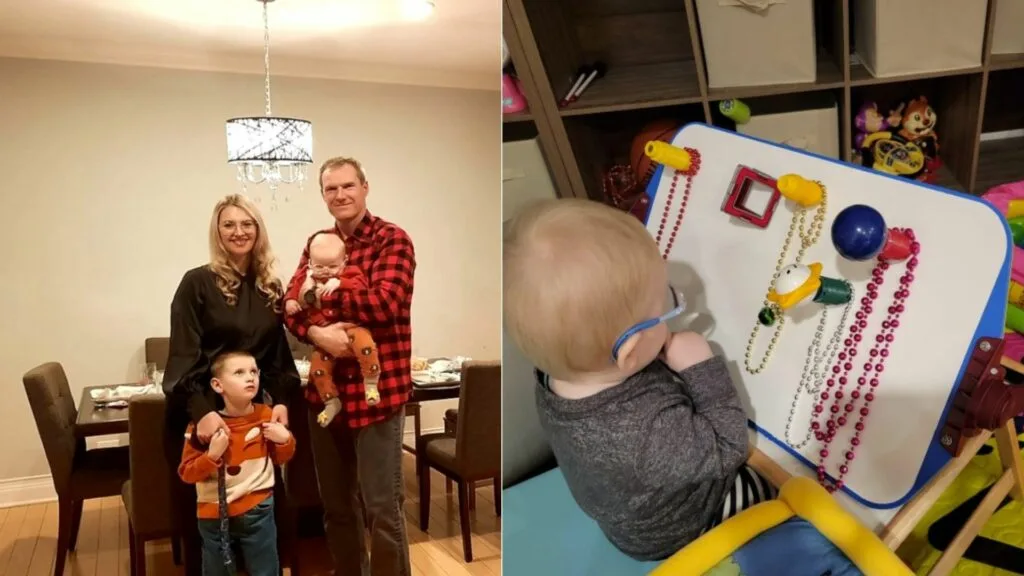 Dovile’s family; Dominic using an APH All-In-One Board
Dovile’s family; Dominic using an APH All-In-One Board
My name is Dovile, and I am a mother of two incredible boys, Jacob (6) and Dominic (1). Jacob is our music lover; he fills our house with music and can’t imagine his day without the keyboard. Dominic is our explorer; he loves toys, books, and all sensory play! They both were born with LCA (Leber Congenital Amaurosis), mutation Cep 290. They both have light perception (reaction to the light), and we still haven’t figured out if Dominic has more than light perception; it’s still under investigation by us, parents.
These two boys are my best teachers as we venture on this curvy, sometimes bumpy, but very interesting road! I am a big fan of adapting or even making toys, books, and other things in our house to help the boys learn, be able to use things, be independent, and thrive. I would love to share a few things we made or adapted with our one-year-old.
Books
I think books play a very important role in a child’s development. They expand vocabulary, help to create a bond with loved ones, and books are very important for pre-braille skills and fine motor skills, etc. We have books everywhere; my boys love touch-and-feel books and books with sounds. They love listening when I read to them too.
Adapting Books
Here are a few examples of how I adapted books (see Pictures 1 and 2). On a sound book I glued different textured fabric and matched the same fabric with the page that has the same story/music/sound. My son would explore the texture; he understood that different buttons represent different music, story, or sound. When he is older, we will try matching textures on the page.
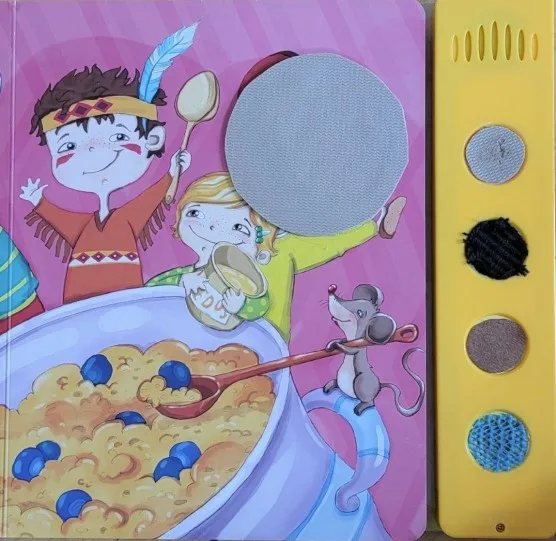 Picture 1. Sound book with 4 buttons and 4 different textures on the buttons. On the page, there is rubbery texture matching the first button.
Picture 1. Sound book with 4 buttons and 4 different textures on the buttons. On the page, there is rubbery texture matching the first button.
To add something interesting and engaging I glue fabrics, textured paper, or some other tactile piece. This helped on pages that didn’t have tactile elements.
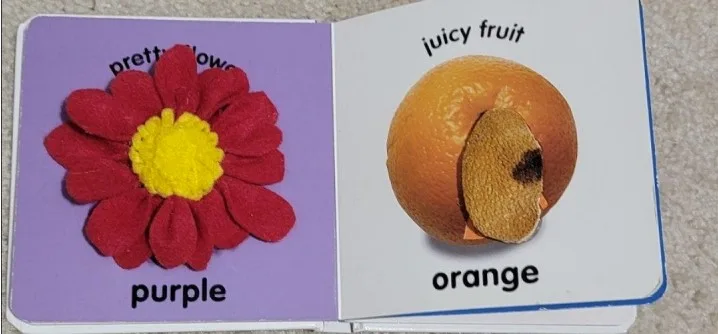 On the left page of the cardboard book, there is a handmade tactile flower that represents the text “pretty flower”. The right page, there is orange peel glued to the page, which represents the text “juicy fruit orange”.
On the left page of the cardboard book, there is a handmade tactile flower that represents the text “pretty flower”. The right page, there is orange peel glued to the page, which represents the text “juicy fruit orange”.
Some books are very easy to adapt by using the real objects of the story. This gives a lot of information to the child and helps to develop a better vocabulary. I keep objects in a zip lock bag or in the box together with the book (See Picture 3).
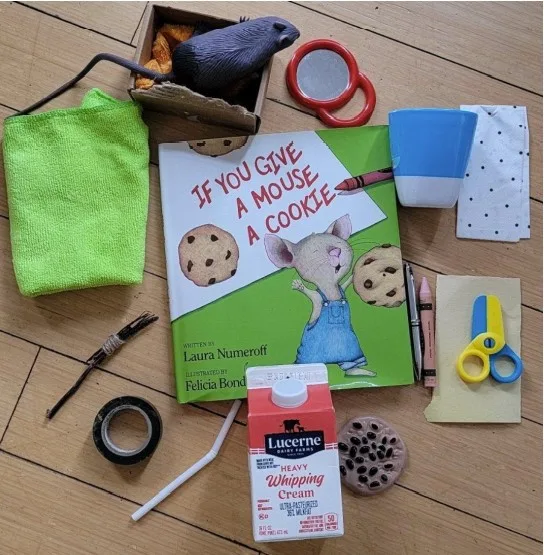 Picture 3. On the center of the picture, there is a book called “ If You Give A Mouse A Cookie”. There are some objects placed around the book. From the top right: Mouse toy, paper box (represents a bed), mirror, cup, napkin, pen, crayon, scissors, paper, toy cookie, whipping cream carton (represents milk), straw, tape, broom, cloth.
Picture 3. On the center of the picture, there is a book called “ If You Give A Mouse A Cookie”. There are some objects placed around the book. From the top right: Mouse toy, paper box (represents a bed), mirror, cup, napkin, pen, crayon, scissors, paper, toy cookie, whipping cream carton (represents milk), straw, tape, broom, cloth.
Play
I started to play with my kids when they were just born. I would sing, dance, massage, and I would use silk scarfs, different fabrics, and feathers to touch newborn legs, feet, arms, belly, back, and face.
We play in every corner of our house. When we move to the different spaces I would name the space, so my child would start to understand where we are and that there are more spaces than the main ones: bedroom or kitchen. I used to think that I needed to buy all the toys, special equipment, etc. But with my second child, I realized there are so many things parents can make and there isn’t a need to buy everything.
Keeping it Simple
Dominic loves containers: metal bowls, baking tins, baking sheets, muffin pans, plastic containers, etc. You can put anything in these like all sorts of balls (see Picture 4) or egg shakers (see Picture 5) (made by putting different grains in plastic eggs and taping them closed), blocks, kitchen items (see Picture 6) (such as a spatula, spoon, and other safe kitchen items). During the summer, I used to pour some water into the baking tin and add flowers (see Picture 7). You can put ice cubes, large pasta, or even real fruits and veggies.
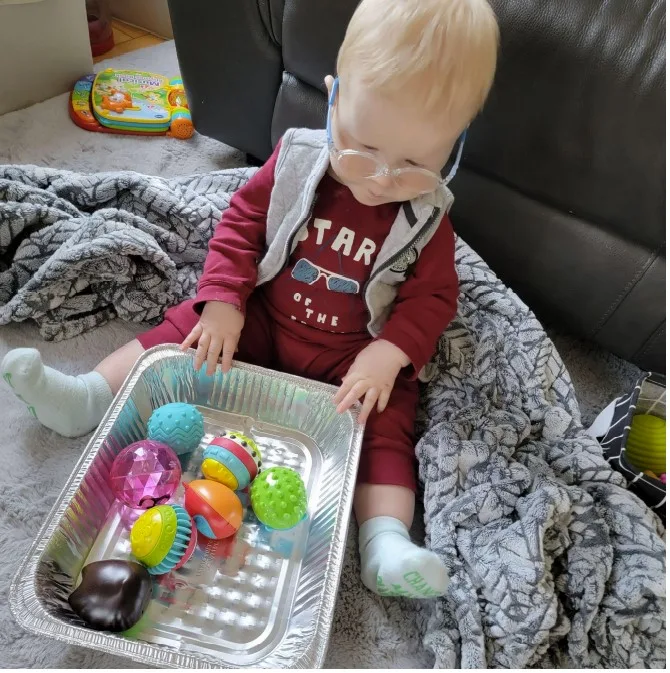 Picture 4. Dominic sitting on the floor with a baking tin filled with various textured balls.
Picture 4. Dominic sitting on the floor with a baking tin filled with various textured balls.
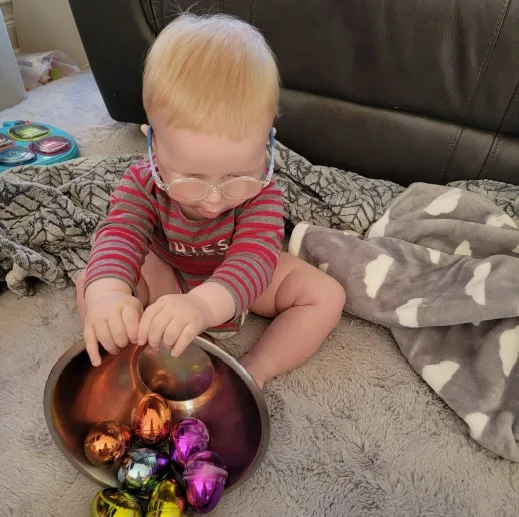 Picture 5. Dominic sitting on the floor holding a bowl filled with various egg shakers.
Picture 5. Dominic sitting on the floor holding a bowl filled with various egg shakers.
 Picture 6. Dominic sitting on the rug and playing with spoons, a pot, and a whisk.
Picture 6. Dominic sitting on the rug and playing with spoons, a pot, and a whisk.
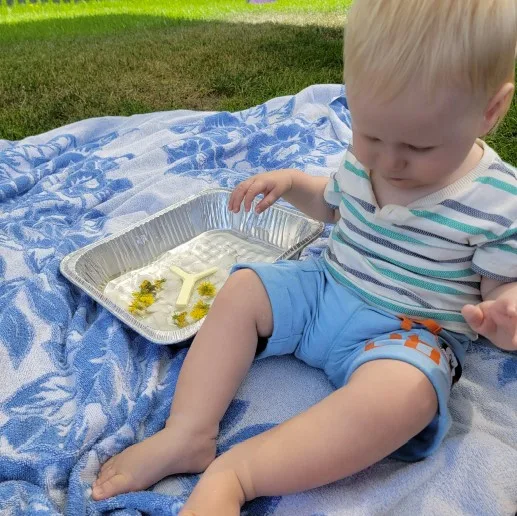 Picture 7. Dominic sitting outside on the towel, playing with the baking tin. In the baking tin, there is some water and the dandelions floating in it. He has a teether floating in the water, too.
Picture 7. Dominic sitting outside on the towel, playing with the baking tin. In the baking tin, there is some water and the dandelions floating in it. He has a teether floating in the water, too.
 Picture 8. Dominic is playing with a muffin pan. In each spot of the muffin pan, there is an egg shaker taped inside.
Picture 8. Dominic is playing with a muffin pan. In each spot of the muffin pan, there is an egg shaker taped inside.
While Dominic didn’t crawl and still wanted to be next to us, we used to sit him in the diaper box next to us (see Picture 9). I made holes on the sides and strung some beads, and I hung the bells so he would be entertained. You can use a laundry basket instead.
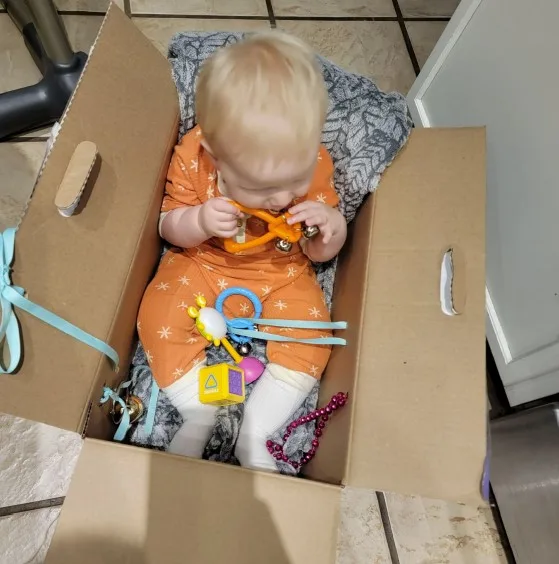 Picture 9. Dominic is sitting in the diaper box and exploring bells.
Picture 9. Dominic is sitting in the diaper box and exploring bells.
Play with Lights
If you have a light box, you can place different items on the light box. For example, you can affix balls (see Picture 10) on the light box using tape or double-sided tape. You can use blocks or shapes (you can cut cardboard shapes and glue some different textures and colors on them). You can place water beads or hair gel and pom poms in the zip lock bag and use it on the light box. Real objects like a spoon, spatula, comb, etc are other considerations you can use. If you don’t have a light box, you can make one (see Picture 11). You need a clear plastic box and LED Christmas lights. Just make sure to keep an eye on it while in use, and don’t leave it on as it can overheat.
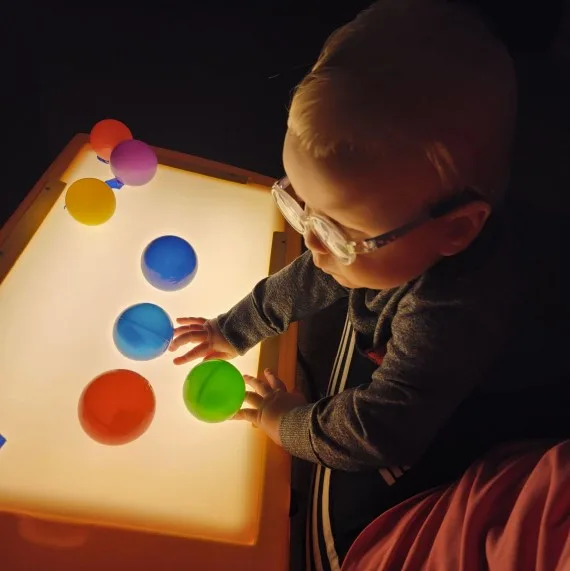 Picture 10. Dominic is playing with a light box. He has colorful balls stuck on it.
Picture 10. Dominic is playing with a light box. He has colorful balls stuck on it.
 Picture 11. Homemade light box. Christmas lights were put in a clear plastic box.
Picture 11. Homemade light box. Christmas lights were put in a clear plastic box.
APH All-In-One Board
We were lucky that our TVI lent us an APH All-In-One Board. I like that it has two sides. One of the sides is black felt and the other is a white magnet board. In the picture, Dominic is sitting in front of the All-In-One board and is playing with magnet toys, Magna tiles, magnet shakers, bells, and beads (see Picture 12).
We use a bed tray to keep the board higher. It’s easier for Dominic to use his remaining vision, and he can sit nicer and work on reaching. The other picture shows Dominic playing with the felt side of the APH All-In-One Board (see Picture 13). We put Velcro on the high-contrast shapes and shiny paper, and we stick them on the board. Also, we use plastic eggs and put some Velcro on them too.
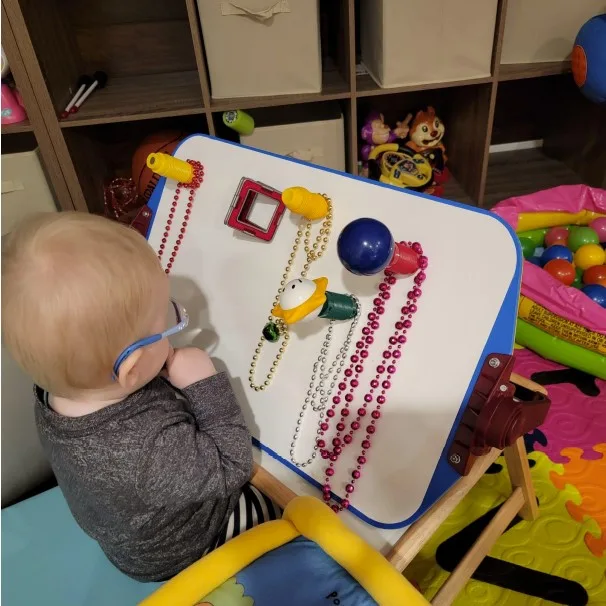 Picture 12. Dominic is sitting on the wedge and playing with the magnet part of the APH All-In-One board.
Picture 12. Dominic is sitting on the wedge and playing with the magnet part of the APH All-In-One board.
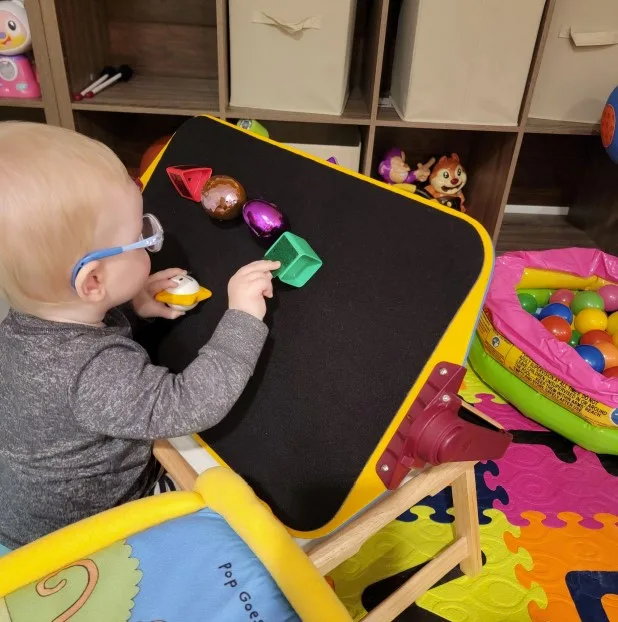 Picture 13. Dominic is sitting on the floor and playing with the black felt part of the APH All-In-one board. He is reaching the green square.
Picture 13. Dominic is sitting on the floor and playing with the black felt part of the APH All-In-one board. He is reaching the green square.
Another Option for Your Boards
If you don’t have access to the APH board, you can make a felt board on your own. You would need cardboard and black felt. I use a hot glue gun to glue felt to the cardboard. And if you want the magnet board, you can find an office magnet board at the store. You can make a sensory board by gluing different textures: shiny paper, different fabrics, sandpaper, ribbon, Velcro, paper circles bent in half and one-half glued to the board, etc. (see Picture 14).
 Picture 14. A sensory board with affixed textured papers, ribbons, sandpaper, feathers, shiny fabric, and Velcro.
Picture 14. A sensory board with affixed textured papers, ribbons, sandpaper, feathers, shiny fabric, and Velcro.
You also can make sensory tiles. On my sensory tiles I glued buttons, feathers, cinnamon sticks, hot glue gun dots, etc. (see Picture 15).
 Picture 15. Sensory tiles. From top left: bumpy sensory tile (made with hot glue), cork tile, smooth tile made of craft foam sheet. Bottom left: feathery tile, cinnamon stick, paper tile, button tile.
Picture 15. Sensory tiles. From top left: bumpy sensory tile (made with hot glue), cork tile, smooth tile made of craft foam sheet. Bottom left: feathery tile, cinnamon stick, paper tile, button tile.
Sensory Boxes
Sensory boxes are the best thing! I love making them, and my kids love them too! I usually make one for each season or holiday (see Pictures 16,17, and18). So, we have one for spring, winter, summer, fall, Easter, Christmas, Halloween, etc.
I have a few without a theme like a box with kinetic sand and with water beads. Those sensory boxes are easy to make; for older children, you can use any grain such as rice, corn, beans, lentils, pebbles, etc. I usually go to the dollar store to find theme-related toys or objects, or find real objects in our home. Walmart, Dollar General, CVS, a marketplace or second-hand stores are also good places to look for things you need.
 Picture 16. Fall sensory box. Inside the box there are corn, real pumpkins, fabric pumpkins, scarecrow hats, acorns, and a pumpkin glow stick.
Picture 16. Fall sensory box. Inside the box there are corn, real pumpkins, fabric pumpkins, scarecrow hats, acorns, and a pumpkin glow stick.
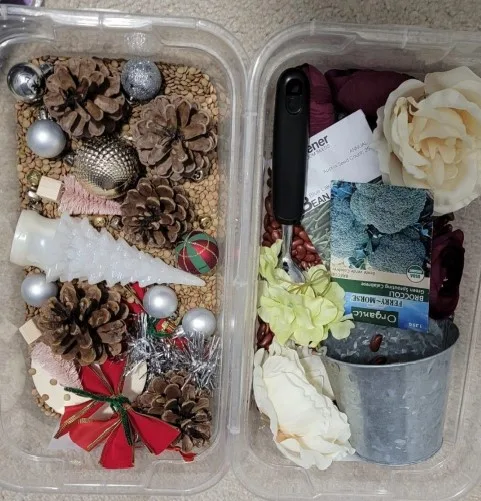 Picture 17. In the picture there are two sensory boxes. The one on the left is a Christmas sensory box, made of lentils, Christmas ornaments, a plastic light-up Christmas tree, Christmas bows, and a miniature Christmas tree. On the right, there is a spring sensory box made of beans, bags of seeds, a bucket, fake flowers, and a scooper.
Picture 17. In the picture there are two sensory boxes. The one on the left is a Christmas sensory box, made of lentils, Christmas ornaments, a plastic light-up Christmas tree, Christmas bows, and a miniature Christmas tree. On the right, there is a spring sensory box made of beans, bags of seeds, a bucket, fake flowers, and a scooper.
 Picture 18. Dominic is playing with a spring sensory box. He is holding a pack of broccoli seeds.
Picture 18. Dominic is playing with a spring sensory box. He is holding a pack of broccoli seeds.
Include Movement with Sensory Play
Sensory play can also be incorporated as a motivator to move. As my son practiced pulling himself to standing, we installed a pull-up bar (see Picture 19) to the wall. I glued some hooks and hung toys and bells on them. He would not only pull himself up, but he would also reach while standing. We also later installed the mirror above the bar; it gives a very nice reflection.
 Picture 19. In the picture, there is a pull-up bar. Over the pull-up bar, there is a mirror glued to the wall. And over the mirror, there are four hooks with some toys.
Picture 19. In the picture, there is a pull-up bar. Over the pull-up bar, there is a mirror glued to the wall. And over the mirror, there are four hooks with some toys.
Take Ideas and Make them Your Own
There are so many resources and ways you can use what you have to make your home sensory rich. It just takes a few extra moments to look at things with a different mindset. Let you child lead the way in how they are exploring and playing.